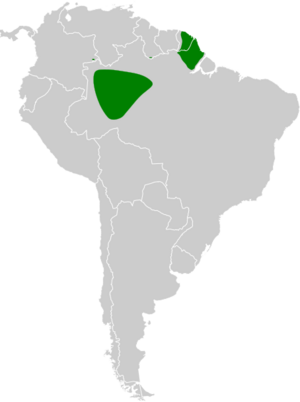Rusty tinamou facts for kids
Quick facts for kids Rusty tinamou |
|
|---|---|
| Conservation status | |
| Scientific classification | |
| Genus: |
Crypturellus
|
| Species: |
brevirostris
|
 |
|
The rusty tinamou is a special bird that lives in the warm, wet forests of South America. It's also called the short-billed tinamou. You can usually find these birds in swampy forests in tropical areas.
Contents
Meet the Rusty Tinamou: A Unique Bird
The rusty tinamou (scientific name: Crypturellus brevirostris) is a type of bird called a tinamou. All tinamous belong to the bird family Tinamidae. They are also part of a larger group of birds known as ratites.
What makes tinamous special is that, unlike most other ratites, they can fly! While they can fly, they aren't super strong fliers. Scientists believe that all ratites, including tinamous, came from ancient birds that could fly. Tinamous are the closest living relatives to these very old flying birds.
What's in a Name? The Meaning of Crypturellus
The scientific name for the rusty tinamou, Crypturellus, has a cool meaning! It comes from three old words:
- kruptos (from Greek) means covered or hidden.
- oura (from Greek) means tail.
- ellus (from Latin) means small or diminutive.
So, when you put it all together, Crypturellus means "small hidden tail." This name fits because their tails are quite short and often hidden by their feathers!
Where Do Rusty Tinamous Live?
Rusty tinamous love living in warm, wet places. You can find them in tropical swamp forests and lowland forests. They usually live in areas up to about 500 meters (about 1,640 feet) above sea level.
These birds are native to several countries in South America. You can spot them in northeastern and northwestern Brazil, French Guiana, and eastern Peru.
What Does a Rusty Tinamou Look Like?
The rusty tinamou is a medium-sized bird, usually about 27 to 29 centimeters (about 10.6 to 11.4 inches) long. They have some interesting colors!
- Their upper parts are a reddish-brown color, with bold black stripes.
- Their throat is white.
- Their chest is a bright reddish-brown.
- Their belly is white.
- Their sides have black stripes.
- The top of their head (their crown) is a chestnut color.
- Their legs are yellowish-grey.
What Do Rusty Tinamous Eat?
Just like other tinamous, rusty tinamous mostly eat food they find on the ground. They also look for food on low-lying bushes. Their diet mainly includes fruits that have fallen from trees.
Besides fruit, they also enjoy small amounts of other foods. This can include tiny invertebrates (like insects), flower buds, soft leaves, seeds, and even roots.
Rusty Tinamou Life Cycle
The male rusty tinamou plays a very important role in raising the young. He is in charge of incubating the eggs. Sometimes, these eggs can come from as many as four different females!
After the eggs hatch, the male tinamou takes care of the chicks. He raises them until they are old enough to live on their own, which usually takes about two to three weeks.
Rusty tinamous build their nests on the ground. They like to hide their nests in thick bushes or between the raised roots of large trees. This helps keep the eggs and chicks safe from predators.


